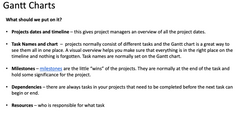![]()
![]()
![]()
Use LEFT and RIGHT arrow keys to navigate between flashcards;
Use UP and DOWN arrow keys to flip the card;
H to show hint;
A reads text to speech;
5 Cards in this Set
- Front
- Back
- 3rd side (hint)
|
Gantt Charts – why are they useful |

|
|
|
|
Different mechanisms design |
- Gears - Pulleys/belt - Cams - Worm gears - Linear actuators - Rack and pinion - Linear Actuators |
7 different |
|
|
Gears |
- Many different forms and designs of gears (spur, etc.) - Gear chains typically used to vary the speed or torque - Can be used to translate/rotate motion |
|
|
|
Pulleys & Belt Driven Systems |
Follow same rules as gears (speed and torque) - Relies on capstan friction (toothless), or timing belts - No issues with clearance of teeth - Requires tensioner - Can easily transfer through angles, corners etc. - - Rotation direction the same |
|
|
|
Rotary -> Linear mechanisms |
- CAMs The profile of the CAM sets the temporal motion of the FOLLOWER - Worm Gear Mechanism - Lead Screw Very high torque, High holding torque, high precision, slow to move. Typically use Stepper motor - Rack & Pinion Faster than a linear actuator, can set speed/ torque through the size of the gear/teeth, few parts to design. Typically use DC motor - Tendon driven Structure Adaptable (think soft fingers and similar) |
|

